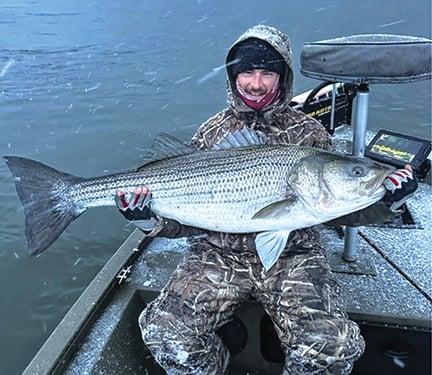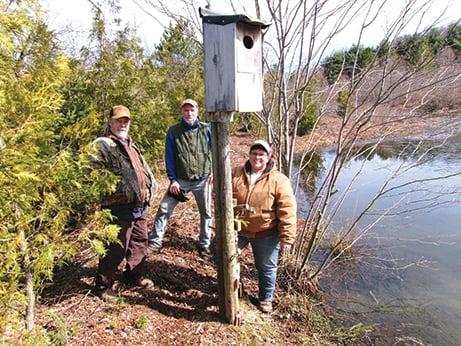Ice-out baits that catch multiple fish species – Outdoor News
Outdoor News may earn revenue from products shown on this page by participating in affiliate programs. Click here to learn more.
What the heck are dual purpose baits? In my universe that translates to multi-species baits. Lures you cast that will reasonably catch more than one species of fish. For a dedicated angler, that’s exactly what we look for.
There’s nothing wrong with being a species-select angler dedicated to bass, trout, salmon or walleye. However, I’ve found the multi-species anglers are a bit more receptive to the idea of dual-purpose baits and they’ll usually catch some nice fish over the course of their day.
Here are a few examples of dual-purpose baits and when I prefer to fish them to kick off the season.
Blade baits
Blade baits work exceptionally well just after ice-out when a lot of game fish are still in deep or moderately deeper water.
I’ve found the 3⁄8 -ounce Steelshad is an excellent choice for probing those fish hugging the bottom as deep as 50-foot to as shallow as 12-foot. I usually cast these lures on 7-foot medium power, fast action rods, using 8-pound Master Braid with a 3- to 5-foot leader of 12- to 15-pound fluorocarbon. This cold-water scenario makes the blade bait a great choice when targeting lake trout, rainbows, perch, smallmouth or walleyes.
MORE FISHING FEATURES FROM OUTDOOR NEWS:
Understand the four stages of river walleyes to catch more fish this spring
Mike Schoonveld: Fishing with lead core line isn’t always simple, but it catches fish
These three overlooked fly patterns have earned their respect on the water
I’ve had my best success when casting out, letting it fall to the bottom on a slack line, then retrieving it back to the boat, employing short deliberate hops of 12- to 18-inches off the bottom.
After each lift I pause at the top for just a bit, and then I’ll follow the bait back to the bottom while maintaining a semi–tight line. Most strikes occur as you lift the bait off the bottom.
Lift the blade bait just enough to feel a good vibration through the rod handle, then pause, and follow the bait down to the bottom. It’s not too technical, but it can provide some fantastic results once you get dialed in on the technique. Check the water you’re fishing in and try to match the hatch whenever possible.
I fish a lot in the Eastern Basin of Lake Ontario where forage fish is the alewive, so I’ll usually start with silver or silver with blue stripe blade bait. These two colors mimic the alewive color very well and it’s not uncommon to land perch, bass, and walleyes, all on the same lure, within a 500-yard stretch.
Swimbait
Another good ice-out bait is a finesse swimbait.
I use a lot of Keitech products and during this cold-water period the 2.8 Fat Swing Impact and the 31⁄2- or 4-inch Easy Shiner are great examples of dual–purpose baits. I also use Big Bite Baits 3.3 Sensation Pro Swimmer. I fish these baits on 1⁄8- to 3⁄8-ounce jig heads depending on the depth and I prefer to use a 7- to 71⁄2 -foot medium light power, fast action rod, 5-pound Master Braid with a 3- to 4-foot leader of 5.7- to 8.4-pound fluorocarbon.
When I see what depth the fish are holding in, I select the proper jig weight, 1⁄8-ounce is good for water as deep as 10 feet, 1⁄4-ounce is good in 10- to 16-feet. Deeper than 16-foot, I prefer to use a 3⁄8-ounce jig head.
My goal is to find the proper weight and speed of retrieve to keep the swimbait about 24 inches above the fish I see on the graph. Most often I’ll use a reel with 5.2:1 speed but try to stay below a 7.2:1 speed.
When I see a fish holding in 12-feet, I’ll cast out and count the lure down to 10 or 11 and begin a slow steady retrieve. I know the swim bait is going to rise a bit when retrieved and I’ll keep that in mind as I work to maintain the 18- to 24-inch distance above the fish’s head.
Most of these fish will feed up looking for horizontal movement and by keeping the bait slightly above them, I believe you’ll greatly increase your odds of generating a bite, versus presenting your bait below the fish.
Again, I want to match the hatch. In offshore open water locations or around main lake islands I want to mimic the alewive and when I fish in the back bays or near-shore, I try to mimic perch, or bluegill.
Jerkbait
Don’t forget about the jerkbait to replicate a minnow.
There are several makes and models to choose from and I’ve enjoyed good success casting Lucky Craft Pointer 100s or Bill Lewis Scope Stik 100s.
These two baits do a great job using stop-and-go retrieves. Cast them out, crank down for three or four turns, then pause for 5 to 12 seconds, reel in the slack line, give the lure another twitch-twitch-pause, wait, then repeat.
These baits usually work best in clearer water as deep as 15 feet, and the colder the water the longer the pause between twitches.
 You’ll need to experiment with the cadence until you find the right rhythm. Once you hook that first fish, simply repeat that cadence and stay with it until the fish stop biting. I’ve had clients fishing side by side, one pausing 10 seconds, the other just five seconds, and the 10-second pause is getting all the bites.
You’ll need to experiment with the cadence until you find the right rhythm. Once you hook that first fish, simply repeat that cadence and stay with it until the fish stop biting. I’ve had clients fishing side by side, one pausing 10 seconds, the other just five seconds, and the 10-second pause is getting all the bites.
In cold water situations speed of retrieve can make or break a good day on the water. My best jerkbait colors are MS American Shad, Aurora Black, Ghost Minnow, Pro Green Gizzard Clear, Pro Perch, and Chrome Blue Orange Belly.
I like to present jerkbaits on a 7-foot medium power fast action rod with 8- to 10-pound fluorocarbon line. I’ve found the reels retrieve speed doesn’t matter, because you don’t work the lure with the reel. Instead, you cast out, employ the stop-and-go retrieve with extended pauses, then crank in the slack line after each pause, and honestly any gear speed from 5.1:1 up to 8.3:1 can accomplish that exact task.
There are many lures that fall into the category of dual-purpose lures, and hopefully this information gets you thinking about the possibilities.
Remember, you’re cold, fishing in cold water, and the fish’s metabolism is cold and slower too, but they still need to eat. It requires a bit of patience and experimentation on your part, but once you find the right formula of depth, lure type, and retrieve cadence, your ice out fishing trip can turn into hot non-stop rod action.
Capt. Burnie Haney contributes to New York Outdoor News’ Fishing Reports and is Chairman of the Jefferson County Sports Fishery Advisory Board and Jefferson County Sportsman’s Representative to NY DEC Region 6 Fish and Wildlife Management Board, 2017 Inductee to the NY State Outdoorsmen Hall of Fame, IGFA World Record Holder, and Owner Operator of New York Fishing Adventures Charters, Henderson Habor, N.Y.
Source: https://www.outdoornews.com/2025/04/03/ice-out-baits-that-catch-multiple-fish-species/







